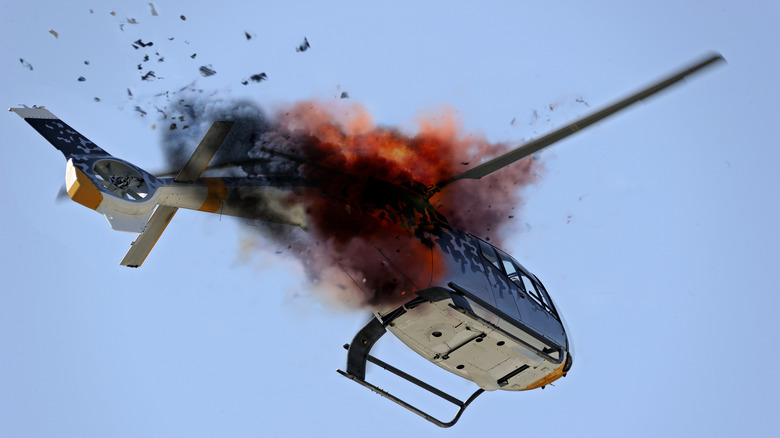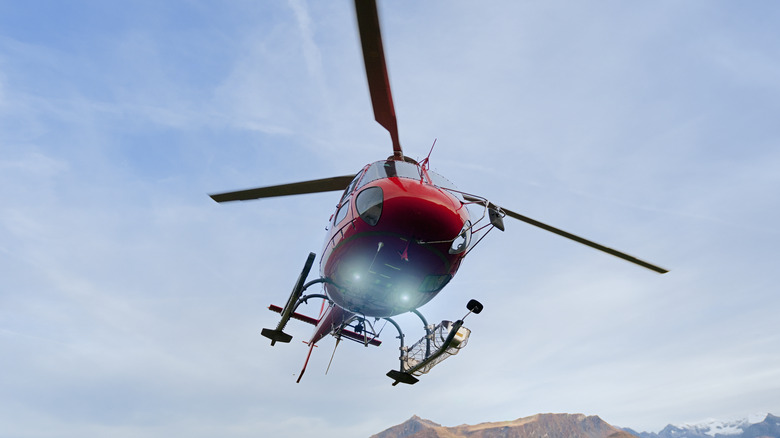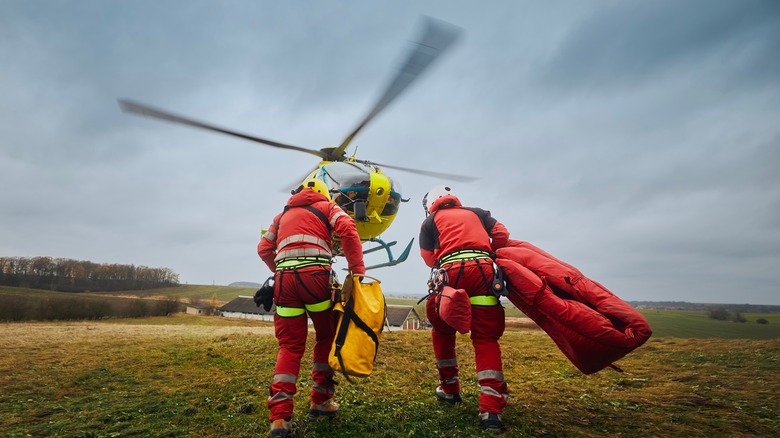The Big Myth About Helicopter Crashes You Shouldn't Believe
Action sequences in movies and television often dramatize the function and failure of vehicles. Helicopters in particular are a big presence in military and spy thrillers, and are often crashed or shot down during the course of a particularly tense scene. Occupants onboard typically emerge battered from the wreckage, and anyone who has actually experienced a crash of this type will certainly attest to the violent force that impact creates.
One thing that Hollywood gets wrong about the typical helicopter crash is the means by which the vessel returns to the Earth. In the case of a badly destroyed helicopter (perhaps one that's been shattered by an anti-aircraft missile), a fast decent and horrendous impact may ensue. For the typical mishap in the air, however, the descent is far less spectacular: a skilled pilot can actually safely bring down their craft without much fanfare.
Contrary to the myths and pop culture understanding of helicopter crashes, the vessels are fairly resistant to simply plummeting back down to the ground in the event of engine failure, damage, or most other faults that lead to an unexpected landing.
Helicopter rotor blades can produce two alternative forces
The lift generated by a helicopter's engine is produced when the top rotor blades are powered on and sped up. They suck air down from above the aircraft and funnel it rapidly downward to produce a massive upward momentum for the vehicle through the air, and are also capable of creating forward momentum as well.
When combined with the rear rotor blade, a helicopter is able to create stable flight in any direction the pilot chooses. However, without the rear blade acting as a counterbalance to the helicopter's main engine and top rotor action, the vehicle would instead begin to spin uncontrollably. If the main power is instead switched off during flight, the rotor above the pilot's head would actually still spin.
Instead of sucking air down through the blades as the vessel drops in altitude, air would rush up through the rotor assembly, spinning it in the process and creating a force called "autorotation." With roughly 600 feet of leeway, the rotors naturally speed up enough to allow the vessel to simply coast down to the ground, just like a skydiver's parachute.
As a result, calm, skilled operators can maintain control of their vessel, even in an emergency that knocks out the flight-enabling engine. It's also worth noting that while the engine produces torque, autorotation that's enacted by the movement of air does not, so pilots don't have to worry about counteracting any spin tendencies while scrambling to land safely.
Helicopters are more accident prone, but this isn't the whole story
The reality of helicopter crashes, surprisingly, closely resembles a scene in the digitized world of "The Matrix." As the heroes depart with their rescued leader in tow in the movie, their craft is shot and begins losing fuel. Rather than drop out of the sky, the helicopter makes an agonizingly slow beat for the nearby buildings as its altitude ticks downward.
In the real world (and apparently one in which humans can fly, too), helicopters have physics on their side. With a skilled pilot behind the stick, managing this emergency situation isn't as chaotic or suspenseful as sensationalized media often makes it out to be. Even so, airplanes experience a lower crash rate than helicopters, with the rotor-powered vessels seeing noticeably higher accident rates than the average across all flight enabled vehicles.
However, this data should be taken with a grain of salt. Helicopters are a purpose-built tool that are often deployed in search and rescue missions, recovery operations, and even in fast attack and close-quarters support roles in the military. These realities make helicopters a versatile flight tool that is put through its paces on nearly every lift-off. Helicopters fly lower, navigate hazards and hindrances, and are called upon to maneuver quickly and sharply, even in clear skies.


